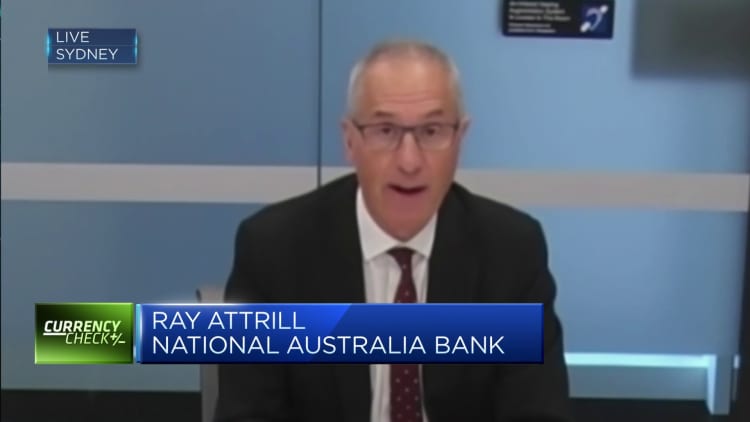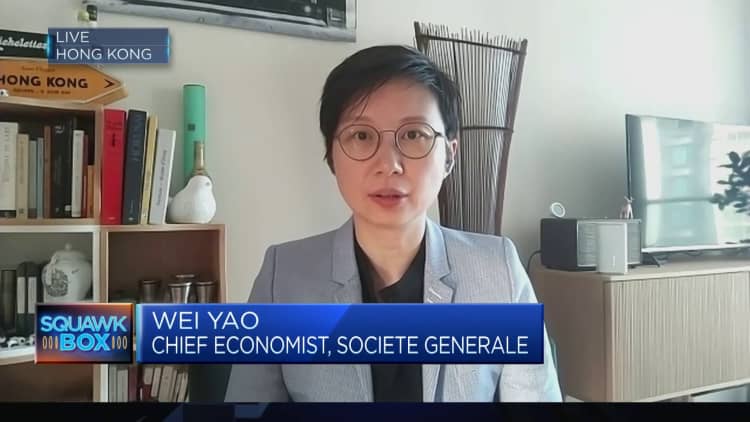

The Bank of Korea was the first to hold its rates steady after being the first to hike in the pandemic era — and could be the first to cut rates in the region.
Gw. Nam | Moment | Getty Images
One by one, countries in Asia-Pacific are putting a pause on their tightening cycles this year after central banks around the world tried to keep pace with the U.S. Federal Reserve‘s aggressive rate hikes in 2022.
While inflation in the region remains well above central bank targets, the problem of balancing economic growth and the depreciating currencies — as a result of the U.S. dollar peak in September — appears to be easing for now.
The dollar index is broadly weaker now on expectations the Fed could soon end its tightening cycle. Inflation is also seen to be less sticky in the region compared to the U.S. and Europe — BofA economists led by Helen Qiao said inflation in Asia’s emerging markets has already “peaked out and started to moderate in the region.”
In fact, economists say some central banks may have already reached the end of their tightening cycles and could begin to shift their focus to what will stimulate growth through rate cuts. Citi and ING are among those expecting to see such moves as soon as the second half of this year.
China and Japan are still outliers in the current global tightening cycle. Here are other central banks in the region that have hit the brakes for now — and what they could end up doing next.
The Bank of Korea was the first to hold rates steady after being one of the first nations to hike in the pandemic era — and could even become the first to cut rates in the region.
Central bank governor Rhee Chang-yong pushed back on expectations of a rate cut later this year, as the Bank of Korea held its rates steady twice after seven consecutive hikes in 2022.
Economists at Citi and ING are among those taking that outlook with a grain of salt. They expect the BOK to cut rates as inflation falls back to target and the extent of the economic damage from its tightening cycle emerges.
Citi economist Choi Ji-uk said in an April 12 note, “BoK will likely begin a rate cutting cycle in August’23 towards 2.00% by the end of 2024, assuming the level of neutral real rate and the inflation target at 2%.”

ING economist Min Joo Kang said, “We think the demand-side pressure will likely turn soft as the restrictive policy environment weighs on consumption and the real economy, meanwhile external demand conditions will improve only gradually in the second half,” according to an April 11 note.
The Reserve Bank of Australia defied market expectations of another hike in March when the central bank held its cash rate target steady at 3.60% – it marked the first halt since starting its tightening cycle in May 2022. Its cash rate is at the highest since May 2012.
The central bank, similar to South Korea’s, pushed back against closing the door completely on further rate hikes. In fact, it explicitly noted that further tightening is still needed.
“The Board expects that some further tightening of monetary policy may well be needed to ensure that inflation returns to target,” the RBA said in a statement.

“Our view is that the data flow will continue to disappoint to the downside in coming months and further rate rises won’t be justified,” economist Diana Mousina of AMP said in a note on April 4, adding she expects the RBA to start cutting by the end of the year.
The Reserve Bank of India held its policy repurchase rate at 6.5% at its last central bank policy meeting in April, despite economists’ expectations for the central bank to hike 25 basis points.
Central bank governor Shaktikanta Das said he expects inflation to moderate over the next 12 months, alongside the central bank lowering its inflation forecasts from 5.3% to 5.2% for the fiscal year starting in April.

Economists at JPMorgan and Societe Generale are among those that expect to see the RBI cut rates by 25 basis points to 6.25% by the fourth quarter of 2023 and another cut to 6.00% by the first quarter of 2024, Refinitiv data showed.
Central banks in Indonesia and Malaysia have all paused their rate hikes for now.
However, there are still central banks in the region that have continued to raise interest rates, including New Zealand and Thailand.
The Reserve Bank of New Zealand surprised markets earlier this month by hiking 50 basis points to 5.25%, exceeding expectations of a smaller hike. The country is still grappling with the economy’s inflation of 7.2%. The next central bank meeting is slated for May 24.
The Bank of Thailand hiked its policy rate by 25 basis points to 1.75% at its March meeting, and said it sees a “continuation of gradual policy normalization to be appropriate in light of the growth and inflation outlook.” Thailand’s central bank meets again on May 31.
24World Media does not take any responsibility of the information you see on this page. The content this page contains is from independent third-party content provider. If you have any concerns regarding the content, please free to write us here: contact@24worldmedia.com
